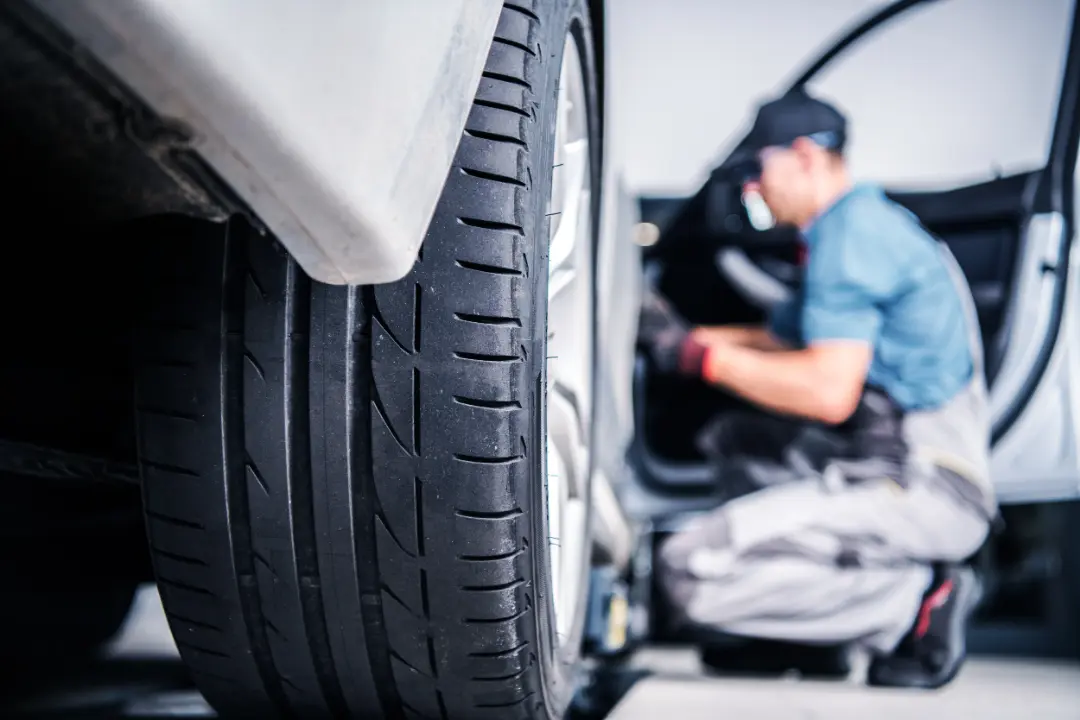Have you ever wondered how fast you can safely drive on your tyres before putting safety at risk? The answer lies in the ‘speed rating on tyres’—a critical measure every driver should understand. This brief guide demystifies speed ratings, revealing why they are crucial to your car’s performance and safety.
Key Takeaways
- Tyre speed ratings, indicated by a letter on the sidewall, reflect the maximum safe speed a tyre can handle at full load capacity, determined through stringent lab testing.
- Selecting the correct tyre speed rating involves considering the vehicle manufacturer’s recommendations and driving conditions, not merely choosing the highest rating available.
- Ignoring tyre speed ratings can result in tyre failure, safety risks, and potential legal issues, such as invalidated car insurance in the event of an accident.
Decoding Tyre Speed Ratings: What You Need to Know
At the heart of every vehicle lies its tyres, and understanding their language can make all the difference in your driving experience. Among the many specifications, understanding the tyre speed rating becomes imperative. These ratings, represented by a letter, indicate the maximum speed a tyre can safely handle at the approved load capacity. But how is this limit determined? It’s not as arbitrary as one may think.
Laboratory tests based on legally approved tyre speed ratings, sustaining the required speed in ten-minute increments. Speed isn’t the only concern; the duration it can safely maintain that speed is equally significant. This facet of tyre safety aids in selecting appropriate tyres for planned speeds, impacting your safety and vehicle performance.
However, the scope of tyre speed ratings goes beyond just safety. The right tyre speed rating also contributes to the following:
- Ride comfort
- Treadwear
- Traction
- Cornering ability
Understanding this aspect of your tyres is part of comprehensive vehicle maintenance and performance services like All Vehicle Services.
The Mechanics Behind Speed Ratings on Tyres
Now that you’ve grasped the significance of tyre speed ratings, it’s time to explore their mechanics. Under simulated load conditions in a lab, tyres undergo incremental speed tests of 6.2 mph for ten-minute intervals. This process continues until the tyre meets the designated speed for its specific rating.
Tyre speed ratings are denoted by letters, starting with ‘A,’ signifying the lowest speed rating, and ascending to ‘Y’ for the highest. However, it’s important to note that the sequence isn’t exhaustive and does not include all alphabet letters.
Each letter signifies a specific top speed at which the tyre can safely carry a load without sacrificing performance or safety. To ensure you select the right tyre for your vehicle, consulting a tyre speed rating chart and considering a tyre load rating chart is essential. Understanding tyres speed rating is crucial for making an informed decision.
Adding to the complexity, the speed ratings range from ‘L’ to ‘(Y)’, each reflecting a specific maximum speed the tyre receives approval for about a car’s maximum speed. These specific maximum speeds form the basis for speed ratings. If you find the mph increments a bit irregular, don’t worry. The irregularity stems from the original ratings being kilometres per hour, following the European system.
Identifying Your Tyre’s Speed Rating
With an understanding of tyre speed ratings and their determination process, it’s time to discern your tyre’s speed rating. The tyre speed index, represented by a single letter on the tyre sidewall, follows the load index number. This letter indicates the maximum speed the tyre can safely maintain while carrying its approved load capacity.
But what about the numbers preceding the speed rating? These two numbers represent the load index, which shows the maximum weight that the tyre can support. The load index and speed rating provide crucial information about your tyre’s capabilities, including its load rating, helping you drive your vehicle safely and efficiently.
Remember, knowledge is power, and understanding your tyre’s speed rating empowers you to make informed decisions about your vehicle’s tyres, ensuring the best performance, safety, and longevity.
Selecting the Correct Speed Rating for Your Car
Selecting the correct speed rating for your car isn’t as straightforward as opting for the highest one. It’s about balancing safety, performance, and suitability for your vehicle and driving conditions. For instance, warmer climates and sports cars are better suited for tyres with higher speed ratings, such as V, Z, W, or Y. On the other hand, ratings like Q and R are ideal for winter 4x4s and heavy-duty light trucks.
Vehicle manufacturers usually suggest tyres with speed ratings surpassing the car’s maximum speed to guarantee safety and adequate performance. You might wonder, “Can I fit tyres with a higher speed rating on my car?” The answer is generally yes, but keeping the tyres matched across axles is essential to maintain consistent vehicle handling. Larger diameter tyres, built for performance vehicles, typically come with higher speed ratings to manage higher speeds effectively.
Always consult the vehicle manufacturer’s recommendations when selecting new tyres or changing their speed ratings. This precaution prevents potential mechanical issues, particularly with 4×4 vehicles, and ensures optimal tyre performance and safety.
The Risks of Ignoring Tyre Speed Ratings
Ignoring tyre speed ratings for convenience or affordability can have serious repercussions. Fitting tyres with a lower speed rating than that recommended by the manufacturer can lead to the tyre overheating and ultimately failing, especially at higher speeds. The last thing you want is a tyre failure while cruising the highway!
Moreover, using tyres with a speed rating lower than the manufacturer’s recommendation can invalidate your car insurance, especially in the event of a crash. Matching or exceeding the original equipment manufacturer’s tyre speed rating is critical to comply with legal standards and ensure vehicle safety.
Ignoring tyre speed ratings is a gamble that is not worth taking. For your safety, performance, and peace of mind, always abide by the recommended tyre speed ratings.
The Impact of Speed Ratings on Vehicle Dynamics
Besides safety, tyre speed ratings profoundly impact vehicle dynamics, making them matter in various aspects. They influence ride comfort, traction, and tread wear. Tyres with higher speed ratings typically enhance grip and braking capabilities, essential for better handling and cornering at high speeds. They are also better at managing heat, crucial for safety and performance during high-speed driving.
However, remember that high-speed-rated tyres might not perform best in colder climates. Still, diligent driving practices like avoiding excessive speed can mitigate rapid tyre wear. Understanding these dynamics helps you make informed decisions when choosing tyres, ensuring you get the most out of your vehicle’s performance while keeping safety paramount.
Upgrading to Higher Speed Rating Tyres
Should you contemplate upgrading to tyres with a higher speed rating, keep a few points in mind. Higher speed rating tyres can improve vehicle performance. They offer enhanced grip and improved braking power, which helps with better handling and cornering at high speeds.
However, while these upgrades can enhance your vehicle’s performance, they may also have drawbacks. Higher speed rating tyres may wear out faster and can underperform in colder weather conditions. Thus, it is crucial to consider your driving conditions and vehicle needs before upgrading.
Maintaining Your tyres for Optimal Performance
Tyre maintenance encompasses the proper tyre speed rating and overall tyre health. Even if your tyres are within the approved speed rating, driving with too much weight can compromise their performance. Routine maintenance should involve cleaning tyres with warm, soapy water and a brush, verifying and maintaining proper air pressures, and rotating tyres per the vehicle’s handbook. These simple steps can ensure even wear and extend tyre life.
For vehicles that are unused frequently, periodic driving or correct storage will prevent tyre deformation. All Vehicle Services offers tyre repair services to help you maintain your tyres for optimal performance and address repairable punctures. So, whether you’re dealing with a puncture or looking to keep your tyres in top-notch condition, All Vehicle Services has covered you.
All Vehicle Services: Your Partner in Tyre Safety and Performance
You can trust All Vehicle Services for tyre safety and performance. They offer:
- A wide range of tyre needs, from budget to premium brands
- Competitive pricing
- Free quotes
- Convenient booking
- Prompt service delivery, including same-day tyre fittings
These are just a few of the benefits they offer.
With over a decade in operation in Sittingbourne, Kent, and a commitment to customer satisfaction, All Vehicle Services offers the following:
- Reliable partner for all your tyre needs
- Team of highly skilled technicians with over 50 years of combined experience
- Deep expertise in tyre services, ensuring that you’re in safe hands
Summary
In conclusion, understanding tyre speed ratings is more than a technical curiosity; it’s fundamental to vehicle safety and performance. From choosing the correct speed rating and understanding the implications of ignoring it to maintaining your tyres and considering an upgrade, every decision impacts your vehicle’s dynamics and safety. With partners like All Vehicle Services, you can be confident that your tyres are in capable hands, giving you the freedom to enjoy the ride.
Frequently Asked Questions
What is a tyre speed rating?
The tyre speed rating is a letter on the tyre’s sidewall that indicates the maximum safe speed for the tyre while carrying its approved load capacity. Make sure to check the speed rating when choosing your tyres.
How are tyre speed ratings determined?
Manufacturers determine tyre speed ratings through laboratory tests. In these tests, tyres are run at incremental speeds under simulated load conditions until they achieve the designated speed for their rating. This process ensures that the tyres can handle the specified speeds safely and effectively.
Can I fit tyres with a higher speed rating on my car?
Yes, you can fit tyres with a higher speed rating on your car, but match the tyres across axles for consistent vehicle handling.
What happens if I ignore tyre speed ratings?
Ignoring tyre speed ratings can lead to overheating and failure at higher speeds and invalidate your car insurance. Be sure to always match the speed rating of your tyres to your vehicle’s capabilities.
What services does All Vehicle Services offer for tyre maintenance?
All Vehicle Services offers tyre repair services for repairable punctures, competitive pricing, free quotes, and convenient booking.

